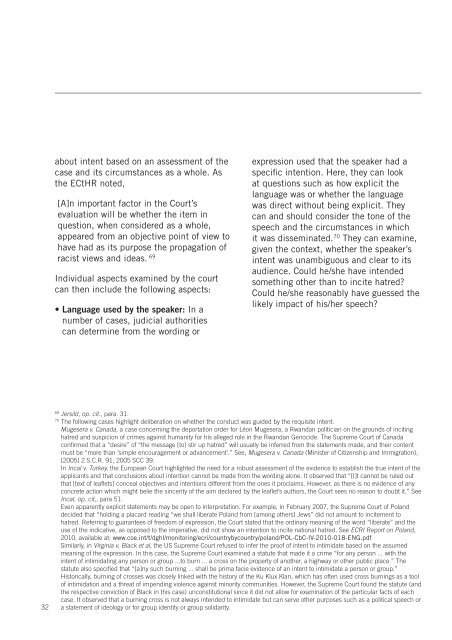ARTICLE-19-policy-on-prohibition-to-incitement
ARTICLE-19-policy-on-prohibition-to-incitement
ARTICLE-19-policy-on-prohibition-to-incitement
Create successful ePaper yourself
Turn your PDF publications into a flip-book with our unique Google optimized e-Paper software.
about intent based <strong>on</strong> an assessment of the<br />
case and its circumstances as a whole. As<br />
the ECtHR noted,<br />
[A]n important fac<strong>to</strong>r in the Court’s<br />
evaluati<strong>on</strong> will be whether the item in<br />
questi<strong>on</strong>, when c<strong>on</strong>sidered as a whole,<br />
appeared from an objective point of view <strong>to</strong><br />
have had as its purpose the propagati<strong>on</strong> of<br />
racist views and ideas. 69<br />
Individual aspects examined by the court<br />
can then include the following aspects:<br />
• Language used by the speaker: In a<br />
number of cases, judicial authorities<br />
can determine from the wording or<br />
expressi<strong>on</strong> used that the speaker had a<br />
specific intenti<strong>on</strong>. Here, they can look<br />
at questi<strong>on</strong>s such as how explicit the<br />
language was or whether the language<br />
was direct without being explicit. They<br />
can and should c<strong>on</strong>sider the t<strong>on</strong>e of the<br />
speech and the circumstances in which<br />
it was disseminated. 70 They can examine,<br />
given the c<strong>on</strong>text, whether the speaker’s<br />
intent was unambiguous and clear <strong>to</strong> its<br />
audience. Could he/she have intended<br />
something other than <strong>to</strong> incite hatred<br />
Could he/she reas<strong>on</strong>ably have guessed the<br />
likely impact of his/her speech<br />
69<br />
Jersild, op. cit., para. 31.<br />
70<br />
The following cases highlight deliberati<strong>on</strong> <strong>on</strong> whether the c<strong>on</strong>duct was guided by the requisite intent.<br />
Mugesera v. Canada, a case c<strong>on</strong>cerning the deportati<strong>on</strong> order for Lé<strong>on</strong> Mugesera, a Rwandan politician <strong>on</strong> the grounds of inciting<br />
hatred and suspici<strong>on</strong> of crimes against humanity for his alleged role in the Rwandan Genocide. The Supreme Court of Canada<br />
c<strong>on</strong>firmed that a “desire” of “the message [<strong>to</strong>) stir up hatred” will usually be inferred from the statements made, and their c<strong>on</strong>tent<br />
must be “more than ’simple encouragement or advancement’.” See, Mugesera v. Canada (Minister of Citizenship and Immigrati<strong>on</strong>),<br />
[2005] 2 S.C.R. 91, 2005 SCC 39.<br />
In Incal v. Turkey, the European Court highlighted the need for a robust assessment of the evidence <strong>to</strong> establish the true intent of the<br />
applicants and that c<strong>on</strong>clusi<strong>on</strong>s about intenti<strong>on</strong> cannot be made from the wording al<strong>on</strong>e. It observed that “[I]t cannot be ruled out<br />
that [text of leaflets] c<strong>on</strong>ceal objectives and intenti<strong>on</strong>s different from the <strong>on</strong>es it proclaims. However, as there is no evidence of any<br />
c<strong>on</strong>crete acti<strong>on</strong> which might belie the sincerity of the aim declared by the leaflet’s authors, the Court sees no reas<strong>on</strong> <strong>to</strong> doubt it.” See<br />
Incal, op. cit,, para 51.<br />
Even apparently explicit statements may be open <strong>to</strong> interpretati<strong>on</strong>. For example, in February 2007, the Supreme Court of Poland<br />
decided that “holding a placard reading “we shall liberate Poland from [am<strong>on</strong>g others] Jews” did not amount <strong>to</strong> <strong>incitement</strong> <strong>to</strong><br />
hatred. Referring <strong>to</strong> guarantees of freedom of expressi<strong>on</strong>, the Court stated that the ordinary meaning of the word “liberate” and the<br />
use of the indicative, as opposed <strong>to</strong> the imperative, did not show an intenti<strong>on</strong> <strong>to</strong> incite nati<strong>on</strong>al hatred. See ECRI Report <strong>on</strong> Poland,<br />
2010, available at: www.coe.int/t/dghl/m<strong>on</strong>i<strong>to</strong>ring/ecri/countrybycountry/poland/POL-CbC-IV-2010-018-ENG.pdf<br />
Similarly, in Virginia v. Black et al, the US Supreme Court refused <strong>to</strong> infer the proof of intent <strong>to</strong> intimidate based <strong>on</strong> the assumed<br />
meaning of the expressi<strong>on</strong>. In this case, the Supreme Court examined a statute that made it a crime “for any pers<strong>on</strong> ... with the<br />
intent of intimidating any pers<strong>on</strong> or group ...<strong>to</strong> burn ... a cross <strong>on</strong> the property of another, a highway or other public place.” The<br />
statute also specified that “[a]ny such burning ... shall be prima facie evidence of an intent <strong>to</strong> intimidate a pers<strong>on</strong> or group.”<br />
His<strong>to</strong>rically, burning of crosses was closely linked with the his<strong>to</strong>ry of the Ku Klux Klan, which has often used cross burnings as a <strong>to</strong>ol<br />
of intimidati<strong>on</strong> and a threat of impending violence against minority communities. However, the Supreme Court found the statute (and<br />
the respective c<strong>on</strong>victi<strong>on</strong> of Black in this case) unc<strong>on</strong>stituti<strong>on</strong>al since it did not allow for examinati<strong>on</strong> of the particular facts of each<br />
case. It observed that a burning cross is not always intended <strong>to</strong> intimidate but can serve other purposes such as a political speech or<br />
32 a statement of ideology or for group identity or group solidarity.


